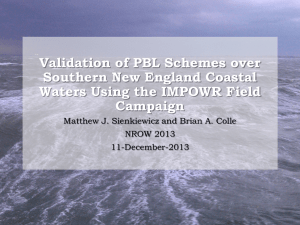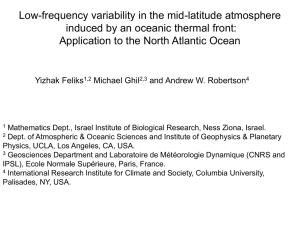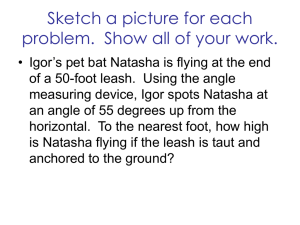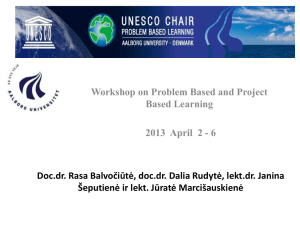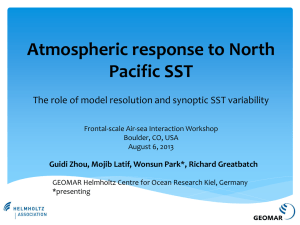Evaluation of WRF PBL Schemes in the Marine Atmospheric
advertisement
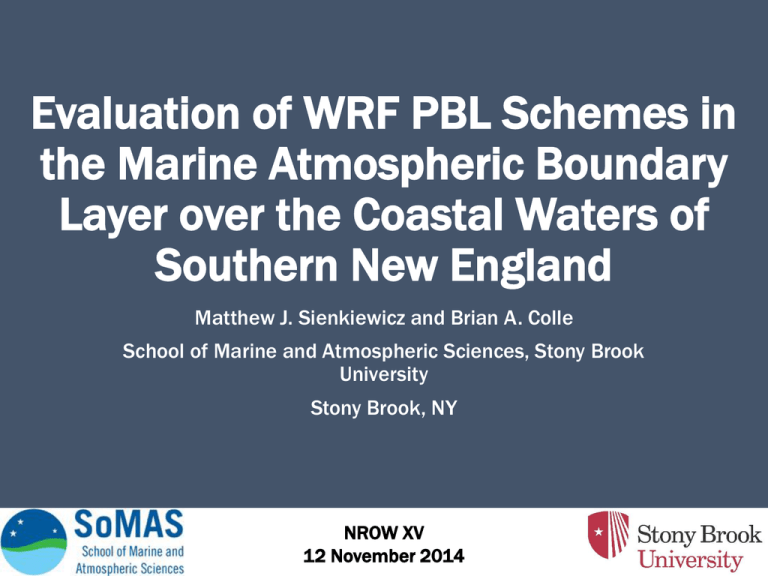
Evaluation of WRF PBL Schemes in the Marine Atmospheric Boundary Layer over the Coastal Waters of Southern New England Matthew J. Sienkiewicz and Brian A. Colle School of Marine and Atmospheric Sciences, Stony Brook University Stony Brook, NY NROW XV 12 November 2014 Coastal New England’s Wind Resource A combination of shallow coastal bathymetry, population density, average wind speed at turbine hub height, and load coincidence make the coastal waters of Southern New England ideal for offshore wind energy. Winter Spring Summer Fall Offshore wind resource maps are created using mesoscale models to account for the sparse observations at and above the water surface. Modeled Seasonal Peak Offshore Wind Resource at 90 meters (hub height). (Dvorak et al. 2012) Motivation Offshore wind resource assessment and operational forecasting are dependent on mesoscale models accurately representing coastal processes Models are known to have wind speed biases at the surface over the water (Colle et al. 2003) Studies of WRF PBL scheme performance have been conducted using coastal and offshore towers and wind profilers in the North Sea and Japan Regional study is needed to address model biases throughout the entire marine boundary layer in the coastal region of southern New England FINO1 Tower in the North Sea (Neumann and Nolopp 2007) Model Wind Speed Biases at NDBC Moored Buoy and C-MAN Stations • Wind speed biases near the surface vary spatially, diurnally and seasonally • Near-surface buoys are not representative of above surface winds due to unknown stability/shear profiles • Accurate representation of MABL winds is partly dependent upon the accuracy of the SST field and the PBL scheme (Ohsawa et al. 2009) Wind Speed biases in m s-1. C-MAN Stations are in blue and moored buoys are in red. Wind speeds were reduced from the lowest model level (~7.5 meters) to the buoy anemometer height of 5 meters similar to Hsu et al. 1994. Motivation Studies verifying WRF PBL schemes above the water have mostly been limited to the North Sea and Japan. More validation is needed within the planetary boundary layer above buoy height. Research Questions What are the short-term forecast biases in the marine boundary layer over the coastal waters of Southern New England? How do these biases vary with height above the water surface? Are there particular stability and flow regimes favoring certain PBL wind biases? Observational Datasets Cape Wind Meteorological Mast 2003-2011 55 meters NDBC Moored Buoys and C-MAN Stations 5 meters Temperature, Pressure 60 meters 41 meters 20 meters 10 meters Wind speed, direction Long-EZ Aircraft Flights 40 Hz measurements of 3D winds, temperature, pressure and humidity Combination of buoy, tower, and aircraft observations provides a dataset for model verification throughout the entire marine boundary layer. Experimental Design and Model Configuration WRF-ARW (version 3.4.1) Six PBL schemes Two First-order (YSU, ACM2) Four TKE-order (MYJ, MYNN2.5, BouLac, QNSE) NARR initial and boundary conditions (3-hourly) 0.5° NCEP Daily SST 38 vertical levels 30-hour forecasts First 6 forecast hours are discarded as model spin-up 4 km 12 km 36 km 90 run dates randomly selected between 2003-2011 Equally divided between warm season (APR-SEP) and cool season (OCTMAR) Equally divided between 00z and 12z model initialization times CW Tower Wind Speed Biases COOL SEASON • Largest biases found during the day • Biases increase in magnitude with height • BouLac scheme shows large biases at night Error bars represent bootstrap 95% confidence intervals. Cape Wind Composite Profiles COOL SEASON • Models are undersheared during the day • Super-adiabatic lapse rates during cool season • Too much mixing of lower momentum from below or higher momentum from above CW Tower Wind Speed Biases WARM SEASON • Largest Biases found at 20-meter level during night • Biases decrease in magnitude with height • BouLac scheme shows increasing biases with height during day Error bars represent bootstrap 95% confidence intervals. Cape Wind Tower Composite Profiles WARM SEASON • Models display too much wind shear below 40 meters • Too little downward mixing of higher momentum • Consistently too cool by 1-2 K throughout lower levels (SST errors?) High SST Variability in the region • Western and central Nantucket Sound heats up in the Spring and stays warm into the Fall • Eastern Nantucket Sound is subjected to strong tidal mixing of cooler water from the Gulf of Maine • Cold water pools over the Nantucket Shoals • Westward excursions of cold water south of MV occur under certain flow regimes CW TOWER 44020 NOAA / Rutgers University National Data Buoy Center Hong et al. 2009 How do the NCEP Daily SST products perform in Nantucket Sound? Large negative warm season bias • For the 5-year period spanning 2009-2013 • Gridded SST products compared with observed water temperature at buoy location What is the relationship between Wind Shear and Stability? Bin-averaged Wind Shear vs. Stability • YSU, ACM2, MYJ and QNSE schemes display too much wind shear in neutral to higher stabilities • BouLac scheme is under-sheared in higher stabilities • Models possibly under-sheared in unstable regimes • Models oversheared in neutral stability What is the relationship between Wind Speed and Wind Speed Bias? Bin-Averaged Mean Error by Modeled Wind Speed Low (high) wind speed biases are found at low (high) modeled wind speeds. Aircraft Observations during IMPOWR Campaign Improving the Mapping and Prediction of Offshore Wind Resources (2013-2014) • AIMMS-20 instrument • Up to 40 Hz measurements of temperature, pressure, relative humidity and threedimensional winds • Targeted Nantucket Sound, Buzzard’s Bay and offshore waters to the south • Flights consisted of level flight legs, spirals up to 1500 meters and slant soundings below 1000 meters Long-EZ Aircraft AIMMS-20 Model Set-up for Long-EZ Flights • 24-hour simulations forced with hourly Rapid Refresh analyses • Prescribed NCEP 1/12th degree SST • One-way nested 1.333 km grid with 5-minute output used for interpolation of model variables to aircraft flight track 1.333 km 4 km Strong Southwesterly Flow with Marine LLJ 23-JUN-2013 18z SFC ANALYSIS • Southwesterly flow dominated by Bermuda High • Land-sea temperature difference of 20 °F • 40 knot LLJ structure developed over coastal waters and SE Massachusetts Aircraft Spiral 2200 UTC 23 JUNE 2013 fhr22 Too Strong Too Stable Too Cool Aircraft Cross-section 23z 23-JUN-2013 SW-NE 300 297 STABLE LAYER 294 18 >19 m s-1 16 14 12 10 RAP-WRF PBL Schemes Winds at 300 meters at forecast hour 23 YSU ACM2 MYJ MYNN2 BouLac QNSE Most schemes display the observed extent of 18-19 m s-1 winds at 300 meters from Buzzard’s Bay to the south shore of Long Island. CHH Sounding 0000 UTC 24 JUNE 2013 fhr24 Too Strong Good Agreement Too stable, too warm How do the initial and boundary conditions affect the jet structure? Winds at 300 meters and NW-SE Cross-sections for lowest 1 km at f24 RAP-WRF NAM-WRF GFS-WRF NARR-WRF • RAP-WRF correctly displays extent of strong winds to south shore of Long Island • NARR-WRF shows weakest jet structure that is retracted to the northeast How do the boundary conditions affect the jet structure? NARR-WRF best handles lowest level winds, but under-predicts LLJ Too Stable Too Cool How does the SST field affect the momentum and thermal structures below jet level? SST Perturbation Experiment • Better represent SST field in Nantucket Sound by warming the western Sound and cooling the eastern Sound. • Warmed upstream regions and decreased land/sea contrast to south while increasing it to north • Maintained continuous SST field SST Perturbation Experiment Results • Perturbing the SST field only slightly affected the below-jet thermal, moisture and momentum profiles Summary of Results • Lowest 60 meters are too stable and too sheared during the Warm Season, resulting in negative wind speed biases at the 20 meter level • Too unstable during the Cool Season, resulting in too much mixing of higher momentum from above and negative wind speed biases increasing with height • Combination of coarse SST field and surface layer scheme over-doing surface fluxes is most likely the cause of misrepresented low-level stability in models • Different initial and boundary conditions yield more varied results than different PBL schemes Thank you! matthew.sienkiewicz@stonybrook.edu SBU-WRF: http://itpa.somas.stonybrook.edu/LI_WRF
